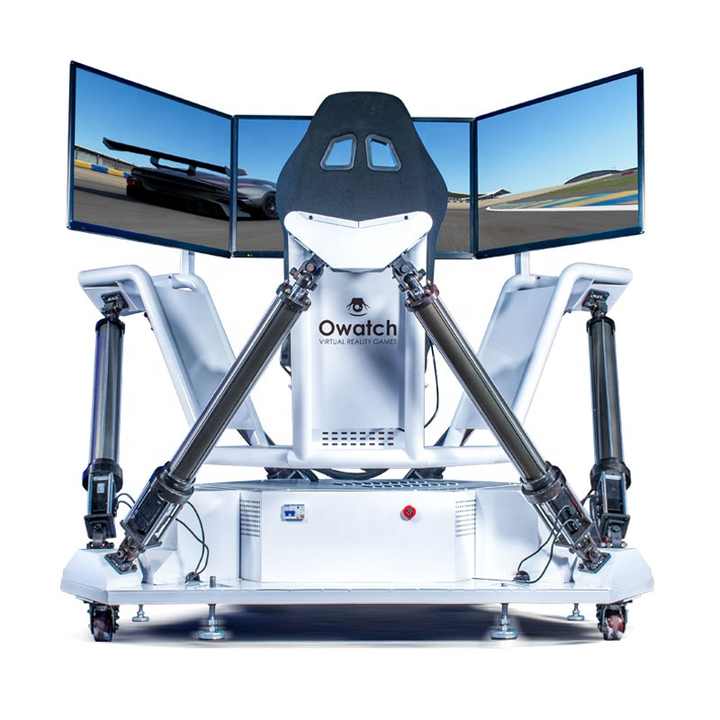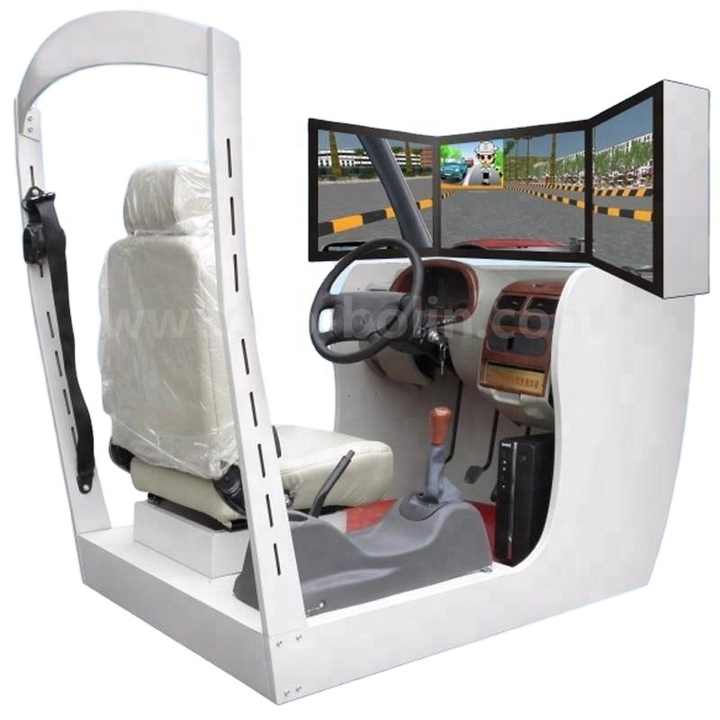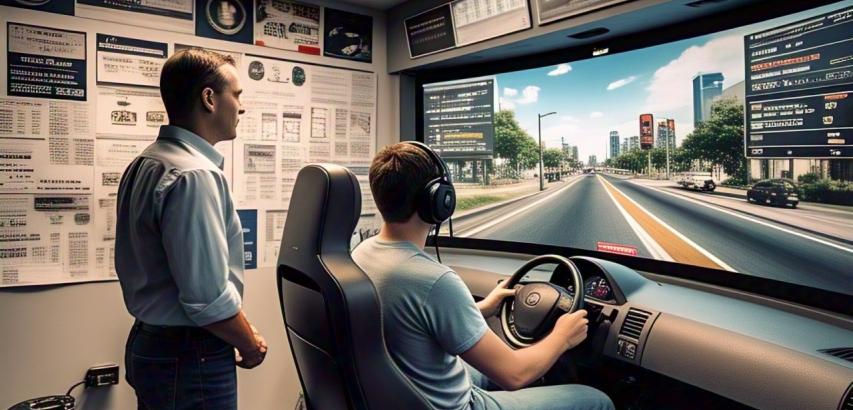Driving simulators are computer-based systems that replicate the experience of operating a vehicle in a safe, controlled virtual environment. Used increasingly by driving schools, fleet trainers, and rehabilitation centers, they provide foundational training before students ever touch a real car.
Key Components & Technology
Hardware:
Cab: Replicates a vehicle cockpit (car/truck/motorcycle) with real steering wheel, pedals (force-feedback optional), gear shift, indicators, and dashboard.
Motion Platforms (Mid/High-End): Provide physical feedback (tilts, vibrations, bumps) enhancing realism (e.g., feeling acceleration, braking, or road imperfections).
Visual System: High-resolution displays (single/multi-monitor setups, curved screens, or VR headsets) creating a wide field of view.
Audio System: Surround sound for engine noise, traffic, horns, weather effects, and instructor communication.
Instructor Station: Separate console for monitoring, controlling scenarios, injecting faults, and debriefing.
Software:
Physics Engine: Simulates realistic vehicle dynamics (acceleration, braking, weight transfer, skidding, tire grip).
Virtual Environments: Detailed 3D worlds replicating cities, highways, rural roads, intersections, and diverse conditions (day/night, rain/snow/fog).
Scenario Library: Pre-programmed exercises (basic controls, parking, lane changes, roundabouts) and complex situations (emergency braking, evasive maneuvers, hazard perception).
Traffic AI: Simulates realistic behavior of other vehicles, pedestrians, cyclists, and animals.
Assessment & Reporting: Tracks and scores performance (speed control, signaling, observation, hazard response, rule compliance), generating detailed reports.
Core Benefits for Driver Training
Enhanced Safety:
Zero-Risk Learning: Practice dangerous maneuvers (skid recovery, emergency stops, high-speed scenarios) without real-world consequences.
Build Muscle Memory: Master basic controls (clutch bite point, steering feel) safely.
Reduce Novice Anxiety: Build confidence in a stress-free environment before real-road exposure.
Accelerated Skill Development:
Focused Repetition: Practice specific skills (parallel parking, hill starts) repeatedly without logistical constraints.
Exposure to Rare Events: Experience hazardous situations (black ice, blowouts, sudden obstacles) impossible to reliably replicate on real roads.
Hazard Perception Training: Sharpen ability to spot and react to potential dangers in complex traffic scenes.
Cost & Efficiency:
Reduce Fuel & Vehicle Wear: Significant savings on real-car operating costs (fuel, maintenance, insurance).
Maximize Road Time: Students arrive better prepared, making real lessons more efficient and productive.
Scalable Training: Train multiple students concurrently with fewer instructors/cars.
Standardized & Objective Assessment:
Consistent Scenarios: Every student faces identical challenges, enabling fair comparison.
Data-Driven Feedback: Objective metrics (reaction time, following distance) identify weaknesses precisely.
Debriefing Tool: Replay sessions to analyze mistakes visually with the student.
Accessibility & Specialized Training:
Accessibility: Train individuals with physical limitations or anxiety disorders in a controlled setting.
Fleet Training: Train bus/truck drivers on specific routes or hazardous cargo protocols.
Rehabilitation: Assess and retrain drivers recovering from injuries or neurological conditions.
License Testing Prep: Familiarize candidates with test routes and maneuvers.
Types of Driving Simulators
Desktop Simulators: Basic (monitor, wheel/pedals). Low cost, good for rules/hazard perception.
Fixed-Base Simulators: Full cockpit, no motion. Mid-range, excellent for core skills & procedures.
Motion-Based Simulators: Full cockpit with motion platform. High-fidelity, essential for advanced dynamics (skids, truck rollover).
VR Headset Simulators: Immersive 360° view. Increasingly popular, offers portability and depth perception.
Limitations & Challenges
Cost: High-fidelity simulators (motion/VR) require significant investment.
Physical Fidelity: Cannot perfectly replicate G-forces, vibrations, or the "feel" of a real car (especially tire grip nuances).
Psychological Fidelity: Some students know it's "not real," potentially reducing engagement or risk perception.
Sensory Limitations: Lack of full peripheral vision (non-VR), wind, and real-world spatial cues.
Motion Sickness: VR or excessive motion can induce discomfort in some users.
Not a Complete Replacement: Essential real-world experience (traffic interaction, weather, judgment) cannot be fully virtualized. Simulators complement, but don't replace, on-road training.
Key Applications in Driving Schools
Beginner Foundation: Mastering controls, rules of the road, basic maneuvers.
Hazard Perception & Defensive Driving: Training anticipation and safe reactions.
Special Conditions Practice: Driving in fog, rain, snow, ice, or darkness.
Specific Maneuver Mastery: Parallel parking, three-point turns, highway merging.
Eco-Driving Training: Learning fuel-efficient techniques.
Assessment & Screening: Evaluating competency before road tests or employment.
Future Trends
AI-Powered Scenarios: More dynamic, unpredictable traffic and hazards.
Hyper-Realistic Graphics & Physics: Leveraging gaming engine advancements (Unreal Engine, Unity).
Wider VR/AR Adoption: More affordable, comfortable headsets enhancing immersion.
Cloud-Based Simulators: Remote access, centralized scenario management.
Integration with ADAS: Training drivers to interact with Advanced Driver Assistance Systems (AEB, LKA).
Data Analytics: Deeper insights into driver behavior for personalized training.
Specialized Vehicle Simulation: Advanced modules for trucks, buses, emergency vehicles, construction equipment.
Key Considerations for Driving Schools:
Define Training Goals: What skills do you need to teach most effectively (basics, hazards, specific vehicles)?
Budget: Balance fidelity with cost. A high-end simulator might not be necessary for basic hazard training.
Space & Installation: Ensure adequate room and proper setup (power, ventilation, network).
Instructor Training: Staff must be proficient in operating the simulator and debriefing students.
Curriculum Integration: Seamlessly blend simulator modules with on-road lessons.
Maintenance & Support: Factor in software updates, hardware repairs, and technical support.
Driving simulators represent a smart investment for modern driving schools, enhancing safety, reducing costs, and producing better-prepared drivers.
Driving school simulators are powerful, transformative tools that elevate driver training. By providing a safe, controlled, and repeatable environment to learn core skills, practice hazardous scenarios, and receive objective feedback, they significantly enhance preparedness for real-world driving. While they cannot replace the necessity of on-road experience, they dramatically improve the efficiency, effectiveness, and safety of the learning process. As technology advances, simulators will become even more immersive, intelligent, and indispensable in creating safer, more competent drivers for the future.
 |  |  |
Buy Driving School Simulator - Amazon
 |  |  |
